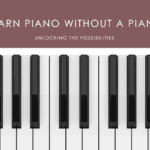Have you ever listened to a beautiful song and thought, “I wish I could write something like that!” Well, guess what – you can! Writing your own songs on piano is an exciting journey that anyone can embark on with the right guidance. In this comprehensive guide, we’ll provide aspiring singer-songwriters, beginners, and hobbyists the tools to craft your own musical masterpieces right from your piano keyboard.
We’ll start with the basics, like choosing a key, building chord progressions, and getting familiar with rhythm and time signatures. Then, we’ll look at bringing your song to life by developing memorable melodies, writing impactful lyrics, and structuring cohesive songs. Along the way, we’ve included handy songwriting tips, examples from hit songs, and exercises to apply what you’ve learned.
So let your creative spirit soar as we explore the rewarding art of writing songs on piano together! Music awaits within you.
Building the Foundation
Before you can write a complete song, you need to build a solid foundation using the basic building blocks of music. Master these fundamentals first and the rest will follow more smoothly!
1. Choosing a Key
The first step is to establish what key you want to write your song in. The key determines the scale and chords that will sound best in your song.
Here are some tips for choosing a piano-friendly key:
- Beginner keys: C major, G major, F major, and D major are easy keys to start with on piano since they have few or no sharps/flats.
- Vocal range: If singing, choose a key that fits in your comfortable vocal range.
- Sound/mood: Keys have different characteristic sounds. For example, D major sounds triumphant, while F minor sounds somber.
- Resources: Listen to songs in different keys to understand their unique moods. Also reference a key cheat sheet for choosing notes and chords.
| Key | Notes | Chords | Mood/Feeling |
|---|---|---|---|
| C major | No sharps/flats | Triads on CDEFGAB | Bright, upbeat |
| G major | 1 sharp (F♯) | Triads on GABCD | Warm, friendly |
| F major | 1 flat (B♭) | Triads on FCGDA | Lighthearted, peaceful |
| D minor | 1 flat (B♭) | Triads on DEFGAC | Sad, somber |
2. Crafting the Chord Progression

The chord progression forms the harmonic backbone of your song, supporting the melody. Here’s how to build one:
- Chord progressions 101: A chord progression is a sequence of chords played in succession. Common progressions are I-IV-V (C-F-G in C major) or I-V-vi-IV (C-G-Am-F).
- Playing triads: Triads (3-note chords) are easy beginner chords. Play them in root position and inversions.
- Original progressions: Experiment with chord substitutions from the key or modal interchanges. Trust your ears!
- Resources: Analyze progressions from hit songs. Refer to music theory sites to understand chord functions better.
Try playing the I-IV-V-I progression in C major to start with. Then mix up the order or substitute chords. Discover what sounds good to you!
3. Understanding Rhythm and Time Signature

Before adding melody, get familiar with some rhythm basics:
- Rhythm: The pattern of long and short notes in music. It’s what makes you tap your foot along with a tune.
- Time signatures: Indicate how many beats per measure and which note value gets the beat. 4/4 is most common with 4 quarter note beats per measure.
- Exercises: Practice playing chord progressions in different rhythmic patterns – whole notes, syncopation, arpeggios, etc. Get creative!
Here are some specific rhythm exercises that can help you improve:
- Practice playing chord progressions in different rhythms – whole notes, syncopation, swing eighths, triplets etc. This builds familiarity with various rhythmic feels.
- Use a metronome and tap or clap rhythmic patterns while counting out loud – start simple with whole and half notes, then add syncopations, ties and more complex rhythms. This develops internal pulse.
- Play call-and-response rhythm phrases between your left and right hand. For example, right hand plays a 2 bar rhythm pattern, left hand echoes it. Great for coordination.
- Improvise rhythmically with your chords and melody ideas. The spontaneity forces you to act in the moment rather than overthink.
- Practice rhythms by clapping or tapping while counting subdivisions. Then transfer to piano. This engages the body in feeling rhythms.
- Master specific syncopated patterns through repetitive practice. Start very slow and gradually increase tempo with metronome.
- Play swing eighths and triplet rhythms over steady quarter notes in left hand. Distinguishing between subdivisions builds rhythmic precision.
- Practice arpeggios and scales in creative rhythmic variations – try alternating fast and slow groups of 4 notes, swing/shuffle feels, syncopations etc.
- Compose your own fun rhythm etude to perform. Incorporate ties, rests, syncopations, tempo changes etc. to make rhythmically interesting.
Bringing Your Song to Life

Once you have the chord foundation ready, now for the fun part – developing the melody, lyrics, and structure to make your song shine!
1. Developing the Melody
The melody brings catchiness and emotion to your song. Here are tips for writing one:
- Chord tones: Target chord tones of current underlying chord on strong beats to get that “right” melodic sound.
- Methods: Hum a tune, improvise on piano, or use known melodic patterns/scales that fit the key.
- Techniques: Try call-and-response (repeating a “question” melody phrase with an “answering” phrase).
- Experiment: Don’t overthink it, let ideas flow freely, and record everything for review later.
Start with a simple 2-4 bar phrase based on your chord progression to build off. Improvise variations of this “seed” idea to expand your melody.
2. Adding Lyrics and Storytelling
Impactful lyrics elevate your song by conveying meaningful messages:
- Emotions: Tap into personal experiences, observations, and imagination to express vulnerability, yearnings, regrets, etc.
- Imagery: Use vivid and sensory details to set the scene and make it relatable. Think sights, smells, textures.
- Cohesion: Ensure your lyrics rhythmically gel with melodic phrasing and structurally fit your song sections.
- Tools: Keep a lyrics notebook to jot down spur-of-the-moment lyric ideas for later use.
Don’t censor yourself initially – pour raw emotions into your lyrics. Refine word choice and polish rhymes after getting main ideas fleshed out.
3. Structuring Your Song
Piecing parts together into an engaging song structure keeps listeners hooked from start to finish.
- Common structures: Verse-chorus, verse-prechorus-chorus, verse-bridge-chorus
- Section functions: Intros set the mood, verses tell a story, choruses are catchy hooks, bridges create contrast
- Transitions: Use rhythmic motifs, instrumental fills, sustained chords, etc. to smoothly shift between sections
- Originality: Break the “rules” once you grasp them! Not all songs follow typical structures.
Map out your song order early so you can deliberately compose sections that flow together. Use chord progression variations, tempo/texture changes, and melody references across sections to tie things together.
Polishing Your Masterpiece

You did it – wrote a complete song! Now to refine details and get it performance ready:
1. Refining and Practicing
Revisit your draft with fresh ears. Identify any rough patches to smooth over:
- Loose ends: Fill in melody gaps, tweak tricky transitions, adjust lyrics that feel forced
- Dynamics: Add crescendos, decrescendos, accents to highlight climax moments
- Layers: Enrich thin-sounding sections with arpeggios, double melodies, pedal points, etc.
- Practice: Isolate tricky segments. Start slow, with hands separately if needed. Use a metronome to lock in tempo.
Don’t rush the editing stage – this polishing makes your good song great! Play around with variations to discover what works best.
2. Recording and Sharing
Capture your final product as an everlasting memory and springboard for promoting your music:
- Recording: Get decent phone memo recordings, produce quality home demos on DAW software, or book professional studio time.
- Sharing: Post on YouTube, Spotify, SoundCloud. Enter song contests. Pitch to music libraries/publishers.
- Community: Join online forums to exchange feedback with fellow musicians. Find co-writers, collaborators, bandmates!
Hearing your composition with full instrumentation or as part of a portfolio will inspire you to keep creating. Enjoy the process and congratulations on becoming a songwriter!
Conclusion
And there you have it – a complete walkthrough of writing songs on the piano for novices and hobbyists alike. We hope this guide has shown you that while songwriting does take some effort, anyone can ignite their musical imagination with the right skills and mindset.
Immerse yourself in the creative world of melodies, lyrics, and chord alchemy. Let your unique experiences and style shine through. Don’t be afraid to experiment freely – you never know what beautiful sounds you’ll stumble upon.
Songwriting is a lifelong journey of self-discovery. May the tips you’ve learned give you the confidence to begin expressing your inner world through your own piano-driven songs today!





